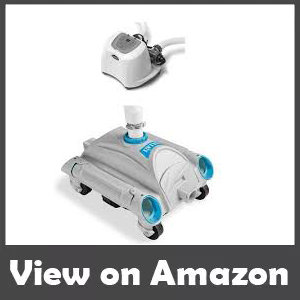Our Top Pool Vacuum Cleaners in 2025
| Vacuum Cleaner | Weight | Price | Check Price |
|---|---|---|---|
| XtremepowerUS Premium Automatic | 12 pounds | $$ | Check Price |
| Zodiac MX6 Automatic Suction | 17.5 pounds | $$$ | Check Price |
| Polaris Vac-Sweep 360 | 14 pounds | $$$ | Check Price |
| AIPER Cordless Robotic Pool Cleaner | 11.5 pounds | $$$ | Check Price |
| DOLPHIN Premier Robotic Pool Cleaner | 36.6 pounds | $$$$ | Check Price |
| DOLPHIN Nautilus CC Automatic Robotic Pool Cleaner | 14 pounds | $$$ | Check Price |
| Hayward W3PVS20GST Poolvergnuegen | 12 pounds | $$$ | Check Price |
Automatic cleaners use the pressure of the pool pump to create a vortex, which lifts dirt and debris. Once in the cleaner, the water is purified and stored in an onboard filter bag. These cleaners are best for pools that don’t have screens or cages, or which are near a large tree. Because they don’t have brushes, they cannot clean steps, but they can clean the bottom of a small pool without any difficulty. Automatic pool cleaners & portable vacuum cleaners are best for a large, dirty pool. Robots can clean a small or large pool in just two to three hours. They can also report the water’s temperature, which is helpful for your cleaning routine. If you have a big family, consider using an automatic cleaner. These devices are great for busy families who don’t have the time to clean the entire pool. Moreover, some even come with a backup battery and a recharging station.
The Dolphin robotic cleaner features an energy-efficient 24V motor and can clean up to three thousand RPM. The machine can learn your pool cleaning routine and can choose between a quick and deep cleaning cycle. The robots do not require any attachments and run on low power. They can clean all kinds of debris. They can even climb upstairs, which saves you a lot of energy. They are also very effective at removing dirt and other debris from the water. There are many pros and cons of robotic pool cleaners. The best robot will work independently of all other equipment and require no hose connections or electrical outlets like a rechargeable pool vacuum cleaner. A robotic cleaner may take several hours to clean a large pool, but it will still need to be plugged into a GFCI outlet. This model’s main advantage is that it does not need to be hooked up to a pump. This means that it does not need to be connected to a pump or water circulation system.
Some of the best pool cleaners are fully automatic, which means that they operate independently from the main pump and filter system. Most of them are powered by a separate electricity source and are usually placed 10 feet away from the pool. These machines use two internal motors. One drives the water through a self-contained filter bag, while the other drives it back into the water. While it is not the most efficient, it is the most efficient option.
There are two main types of pool cleaners: pressure-side cleaners and suction-side cleaners. These cleaners depend on the main pump and filter systems to operate properly. These cleaners can’t remove particles smaller than the pore size of their filter elements. Unlike vacuum cleaners, they can’t get rid of small debris, but they can hSmart robotselp prevent debris from getting into the water. But, they aren’t the only types of pool cleaners.
are a great choice for home pools. They typically consist of a robot, a head unit, and a waterproof data cord. A smart robot is a robotic device that uses artificial intelligence (AI) to learn the layout of the pool and perform tasks such as cleaning a pool’s walls. Some cleaners also have a deflecting mechanism to remove large debris. These cleaners are a little more expensive than automatic ones, but they do the job.

